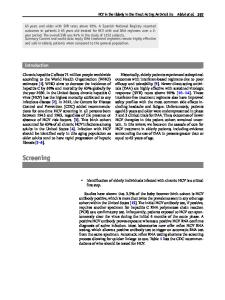Hepatitis C Virus Cure and Obesity: Watch the Weight
- PDF / 141,055 Bytes
- 2 Pages / 595.276 x 790.866 pts Page_size
- 14 Downloads / 424 Views
Department of Gastroenterology, Kaiser Permanente San Francisco Medical CenterSan Francisco, CA, USA; 2Division of General Internal Medicine, Department of Medicine, University of California San Francisco School of Medicine San Francisco, CA, USA.
J Gen Intern Med DOI: 10.1007/s11606-020-06004-9 © Society of General Internal Medicine 2020
has reached an astounding prevalence in the genO besity eral population, and the burden of disease worsens with increasing age. Through unclear mechanisms, greater body mass index (BMI) is associated with an increased rate of death from all causes even when accounting for confounders such as smoking history or presence of comorbid illness.1 Obesity is the primary risk factor for the development of non-alcoholic fatty liver disease (NAFLD), which is becoming the most common cause of chronic liver disease and hepatocellular carcinoma (HCC) as well as the leading indication for liver transplantation in the U.S. Development of concomitant NAFLD is associated with more rapid progression of hepatic fibrosis in patients with other causes of liver disease, including chronic viral hepatitis and alcoholic liver disease. It is therefore important to take note of the current prospective observational cohort study by Do, et al.2 of an impressively large sample of over 11,000 veterans with chronic hepatitis C virus (HCV) infection successfully treated with direct acting antiviral (DAA) medications, showing that more than 20% of patients gained 10 lbs or more within two years of achieving a sustained virologic response (SVR). The prevalence of obesity in this HCV-infected cohort was 36.8% at baseline, significantly lower than the 41% prevalence of obesity among the overall veteran population. Weight gain was more commonly observed with younger age, baseline overweight or obesity, cirrhosis, and moderate alcohol use. Several questions arise from this study. First, is the excess weight gain specifically related to the use of DAA therapy? Many classes of medications are associated with weight gain, such as antipsychotics, antidepressants, hypoglycemic agents, glucocorticoids, and beta blockers, and typically, the weight gain can be reversed after discontinuation of treatment. Some HIV antiretrovirals are associated with weight gain, but as a class, antiviral drug-induced weight gain is not a common finding. The authors attempted to remove the DAA itself from the equation by determining baseline weight at three months after DAA treatment was completed, rather than before DAA treatment, and then to determine the change in weight with the measurement again two
years later. However, in order to determine if the weight gain effect is specifically due to the use of DAA therapy, the patients should have been compared to historical controls of HCV patients who were untreated and HCV patients achieving SVR using interferon-based regimens. Second, is the excess weight gain due to the eradication of HCV? The authors postulated on potential mechanisms by which an HCV cure could lead to weight gain, includin
Data Loading...











